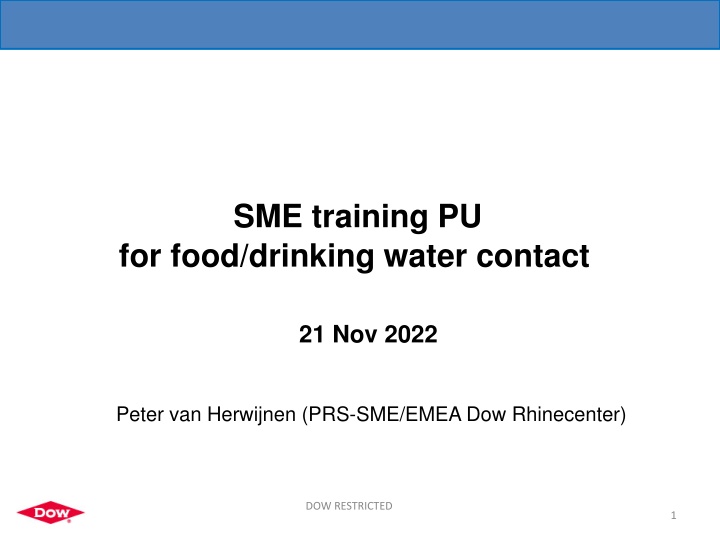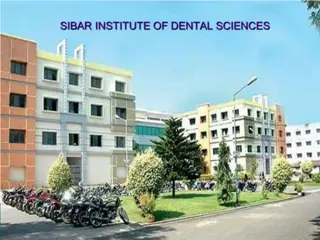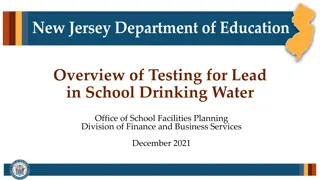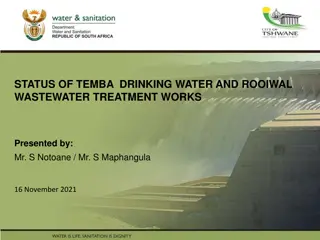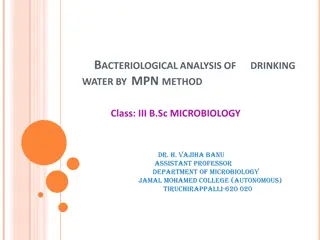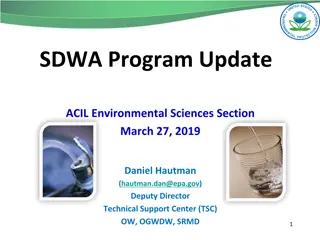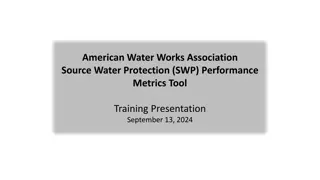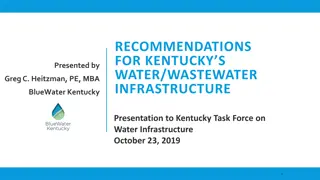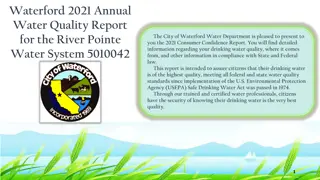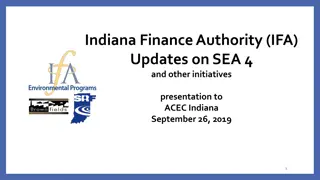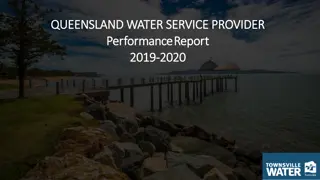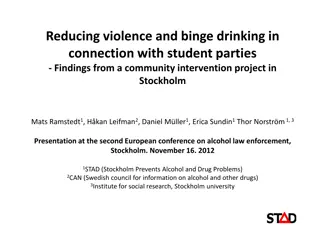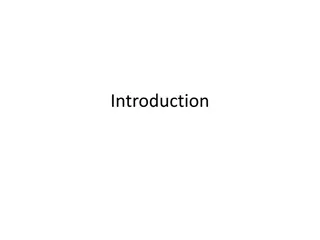Regulatory Compliance for PU Products in Food and Drinking Water Contact
This document outlines the regulatory requirements for polyurethane (PU) products used in food and drinking water contact, including guidelines for monomers, additives, and substances allowed, as well as compliance procedures for both food and drinking water directives. It also details service activities related to assessing compliance, drafting statements, and managing regulatory issues in the PU business sector. Formulation components and restrictions for PU products are also discussed.
Download Presentation

Please find below an Image/Link to download the presentation.
The content on the website is provided AS IS for your information and personal use only. It may not be sold, licensed, or shared on other websites without obtaining consent from the author.If you encounter any issues during the download, it is possible that the publisher has removed the file from their server.
You are allowed to download the files provided on this website for personal or commercial use, subject to the condition that they are used lawfully. All files are the property of their respective owners.
The content on the website is provided AS IS for your information and personal use only. It may not be sold, licensed, or shared on other websites without obtaining consent from the author.
E N D
Presentation Transcript
SME training PU for food/drinking water contact 21 Nov 2022 Peter van Herwijnen (PRS-SME/EMEA Dow Rhinecenter) DOW RESTRICTED 1
EU regulation PU products for food and drinking water contact Food contact Subject to general requirements under the plastics regulation 10/2011 Monomers,other starting substances and additives have to be on the Union positive list subject to applicable restrictions (Qm, SML, specification) Aids to polymerization (AP) and Polymerisation Production Aids (PPA s) and solvents don t have to be listed and are subject to self-risk assessment Prepolymers are considered authorized if made from listed monomers Suppliers have to provide a Declaration of Compliance Drinking water contact Subject to requirements under the revised Drinking water directive 2020/2184 Monomers, other starting substance, additives, solvents and AP/PPA s have to be on the positive list = 4 MS Common approach Core/Combined list (substances listed in 10/2011 are authorized, AP/PPA s don t have to be considered if not CMR and <0.02%) Composition has to be disclosed to accredited certifying labs DOW RESTRICTED - For internal use only 2
SME services and projects with the PU business Service activities Assessment regulatory compliance Drafting food compliance statements and customer communications Safety assessments, business risk reviews Resolving compliance issues at customers or test labs Advocacy, regulatory / science development, external networking (trade groups, authorities, test labs) Tracking regulatory developments, impact assessment/communication to the business (e.g. reprotox classification TMP) Provide regulatory trainings Projects Approval DIPRANE 1025 and HYPERLAST 153 for food contact Substitution ERL 4122 with ESBO Synthetic cork (Warenwet Chapter IX) Assessment PU systems for drinking water contact DOW RESTRICTED - For internal use only 3
PU products / formulations Formulation components: Aromatic isocyanate (MDI/TDI) Typically as isocyanate functional prepolymer Polyol Polyester/polyether polyol Additives Anti-oxidants Flow agent, defoamer (siloxane) Catalysts (Aid to Polymerisation - AP) Tert amines, tin compounds etc Polymerisation Production Aid (PPA) Non-intentionally-Added- Substances (NIAS) Oligomers (Cyclic polyesters- CPO), impurities, degradation products, Primary Aromatic Amines (PAA s) DOW RESTRICTED 4
Compliance assessment + approval PU system DIPRANE 1025 Business Risk Review (BRR) documentation package Step 1: Assessment compositional compliance - listing of all substances (IAS/NIAS) with functionality - concentration levels of non-reactive substances - information of positive listing and self-derived SML s (obtain DoC s from suppliers) Step 2: Analytical assessment - determination of residual levels of reactive monomers - NIAS screening Step 3: Estimation of migration levels based on worst case calculation for target application (100% migration from 1000 micron film) Step 4: Drafting DoC and NIAS statement Step 5: Compliance testing and approval final article by test lab Eurofin APPROVAL ! DOW RESTRICTED - For internal use only 5
Monomers: MDI (3 isomers) 4,4 methylenediphenyldiisocyanate (MDI) (CAS No 101-68-8) typically 97.0 - 98.5% FCM No 198 (SML =ND, Qm = 1 mg/kg expressed as NCO) Carc Cat 2 ! 2,4-diphenylmethane diisocyanate (MDI) (CAS No 5873-54-1) typically 1.5-3% FCM No 490 (SML = ND, Qm = 1 mg/kg expressed as NCO) Carc Cat 2! 2,2-Diphenylmethane diisocyanate (CAS No 2536-05-02) non-listed impurity, typically <0.1% Self derived restriction by TERC: SML = ND and Qm = 1 mg/kg expressed as NCO As the 2,2/MDI isomer is less reactive than 4,4 and 2,4-MDI, the residual levels of NCO groups will be higher thus increasing the risk of non-compliance, therefore industry agreed to set a voluntary max level of 0.8% for 2,2/MDI isomer in MDI monomer for food contact DOW RESTRICTED - For internal use only 6
Monomers: MDI oligomers and polymers Oligomeric MDI (CAS No 39310-05-9) MDI oligomers are obtained by partially polymerizing MDI monomers with TEP Oligomeric MDI is considered an authorized pre-polymer manufactured with the listed monomer MDI (Art 6 of 10/2011) Polymeric MDI (CAS No 9016-87-9) Polymeric MDI is obtained by coreacting aniline, formaldehyde and phosgene (not polymerization of MDI) As aniline is not listed in Annex I as an authorized monomer, polymeric MDI is not considered an authorized polymer or prepolymer Toluene 2,4/2,6 -di- isocyanate (TDI) (CAS No 91-08-7) FCM No 167 (SML =ND, Qm = 1 mg/kg expressed as NCO) Carc Cat 2 ! Hexamethylene diisocyanate (HDI) (CAS No 822-06-0) FCM No 372 (SML =ND, Qm = 1 mg/kg expressed as NCO) not classified as Carc Cat 2 ! DOW RESTRICTED - For internal use only 7
Monomers: glycols, polyols + prepolymers Propylene glycols Monopropylene glycol (MPG) Dipropylene glycol (DPG) Tripopylene glycol (TPG) Polypropylene glycol (PPG) Voranols FCM 109 , no SML (dual use: E 1520) FCM 257, no SML FCM 634 , no SML FCM 639, no SML Monomers in polyester polyols Ethylene glycol (EG) Diethylene glycol (DEG) Triethylene glycol (TEG) Polyethyleneglycol (PEG) 1,4 Butanediol (BDO) Polytetrahydrofuran (PTMEG) not listed (prepolymer) Trimethylolpropane (TMP) FCM 227, SML(T)= 30 mg/kg FCM 263, SML(T)= 30 mg/kg (as EG) FCM 266 , no SML FCM 638, no SML FCM 254, SML(T) = 5 mg/kg FCM 141, SML = 6 mg/kg (to be classified Reprotox Cat 2!) TERC derived a SML= 4.4 mg/kg based on reprotox data FCM 303, no SML Adipic acid Prepolymers made of listed monomers MDI/TDI prepolymers: reaction product of polyols with excess of isocyanate monomer Considered authorized according to Art 3.6.d (derogations from positive listing) subject to SML s applicable for monomer DOW RESTRICTED - For internal use only DOW RESTRICTED - For internal use only 8 8
Additives DOW RESTRICTED - For internal use only 9
AP and PPAs (salt & pepper): subject to self risk assessment DOW RESTRICTED - For internal use only 10
APs: tin catalysts Tin compounds are suspected of endocrine activity (black listing) many are classified (EU/notified CLP) as reprotoxic substances DOW RESTRICTED - For internal use only 11
Other APs subject to self risk assessment DOW RESTRICTED - For internal use only 12
NIAS (Non-Intentionally Added-Substances) Primary Aromatic Amines (PAA) Due to partial hydrolysis of isocyanate groups, Primary Aromatic Amines (PAA) can be formed which should not be detectable in food (Annex II of regulation 10/2011). The Limit of Detection (LOD) for PAA s in the plastics legislation 10/2011 (latest amendment Regulation (EU) No 2020/1245) is 0,002 mg/kg. Cyclic siloxanes in siloxane based additives (PDMS) D3: Hexamethylcyclotrisiloxan (CAS No 541-05-9): TTC Cramer class 3 D4 : Octamethylcyclotetrasiloxan (CAS No 556-67-2): DNEL = 3,7 mg/kg bw/d (Reprotox) D5 : Decamethylcyclopentasiloxane (CAS No 541-02-6): DNEL = 5 mg/kg bw/d D6: Dodecamethylcyclohexasiloxane (CAS No 540-97-6 : DNEL = 1,7 mg/kg bw/d Cyclic polyesters (CPO) Linear or cyclic polyester oligomer (CPOs) can be formed as side reaction products in the manufacturing of polyesters and polyester polyols. These are subject to self-risk assessment according to Art 19 of 10/2011 . It is expected that the ester bonds of CPO s will cleave rapidly after ingestion and generate back the starting monomers that are listed in 10/2011. CPO s were assessed for their toxicity and were classified in Cramer class I and III with SML s of 1800 and 90 g/kg (see FEICA report) O O O O Impurities DOW RESTRICTED - For internal use only 13
DoC s and NIAS statements DIPRANE 1015, HYPERLAST 153 DIPRANE 1025 system : DoC + NIAS statement HYPERLAST 153 : DoC + NIAS statement DOW RESTRICTED 14 14
BACK UP SLIDES DOW RESTRICTED - For internal use only 15
Hyperplast 153: approval for drinking water contact Annex 2: Declaration of formulation by the manufacturer for organic materials (Recommendation for attestation of conformity of product hygiene suitability for drinking water) DOW RESTRICTED - For internal use only 16
Synthetic cork project - Thomas Mosciatti Warenwet Chapter IX : Wood and cork Hyperplast 153: approval for drinking water contact 2. Requirements for manufacture c. adhesives and thickening agents polyurethane, in accordance with Chapter I (plastics refers to 10/2011) Background: - Customer AMORIM interested in PU binder for synthetic cork (10-20% PU binder) - Competitive product based on TDI - TDI 100 from Borsodchem/Desmodur T 80 from Covestro contain Irganox 1076 (compliant with 10/2011) - Dow s TDI (VORANATE T 80) is not food compliant due to presence of non-listed anti-oxidant Irganox 1135 - Castoroil not compliant with 10/2011 (FCM No 527 no SML) STATUS? . DOW RESTRICTED - For internal use only 17
